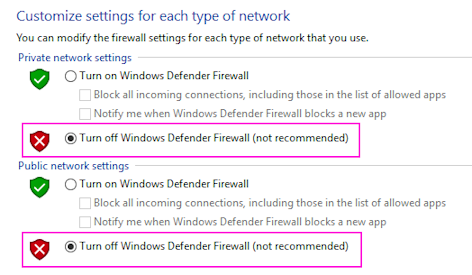Configure the firewall
Sym3 Operator is using different port to communicate with client applications. By default, all ports should be blocked by the firewall.
Option 1: Create a rule for Sym3 Operator (Recommended) Manu
- Open the Windows Defender Firewall application (Windows Key + “Firewall”)
- Click on “Advanced Settings”
- Click on Inbound Rules
Sym3 Operator Web
- Create a new Inbound Rule
- Select Port
- Click Next
- Set Specific local ports:
4031 - Click Next
- Select Allow the connection
- Click Next
- Give a name to the rule, for example
Sym3 Operator Web
Or from the Command Prompt:
netsh advfirewall firewall add rule name="Sym3 Operator Web" dir=in action=allow protocol=TCP localport=4031
Sym3 Operator Service
- Create a new Inbound Rule
- Select Port
- Click Next
- Set Specific local ports:
20000,20005,27000,20031 - Click Next
- Select Allow the connection
- Click Next
- Give a name to the rule, for example
Sym3 Operator Service
Or from the Command Prompt:
netsh advfirewall firewall add rule name="Sym3 Operator Service" dir=in action=allow protocol=TCP localport=20000,20005,27000,20031
Sym3 Alarm Service
- Create a new Inbound Rule
- Select Port
- Click Next
- Set Specific local ports:
20010,20011,20012,20013,20021 - Click Next
- Select Allow the connection
- Click Next
- Give a name to the rule, for example
Sym3 Alarm Service
Or from the Command Prompt:
netsh advfirewall firewall add rule name="Sym3 Alarm Service" dir=in action=allow protocol=TCP localport=20010,20011,20012,20013,20021
Sym3 Replay Service
- Create a new Inbound Rule
- Select Port
- Click Next
- Set Specific local ports:
25000,25500-25550- 25000 is the connection and controlling port
- 25500 to 25550: range of websocket ports. Each replay connection will use one port. You can fine tune this range based on the number of maximum connection that your license has. 25500 is the starting port. So the range will be from
25500to25500 + MaxReplayConnectionFromLicense - 1
- Click Next
- Select Allow the connection
- Click Next
- Give a name to the rule, for example
Sym3 Replay Service
Or from the Command Prompt:
netsh advfirewall firewall add rule name="Sym3 Replay Service" dir=in action=allow protocol=TCP localport=25000,25500-25550
Sym3 Auth Server
- Create a new Inbound Rule
- Select Port
- Click Next
- Set Specific local ports:
6050,6051 - Click Next
- Select Allow the connection
- Click Next
- Give a name to the rule, for example
Sym3 Auth Service
Or from the Command Prompt:
netsh advfirewall firewall add rule name="Sym3 Alarm Service" dir=in action=allow protocol=TCP localport=6050,6051
Option 2: Disable the firewall (Not Recommended)
You can decide to totally disable the firewall. This is not safe and it is NOT the recommended way.
- Open the Windows Defender Firewall application (Windows Key + “Firewall”)
- Click on “Turn Windows Defender Firewall on or off”

Here is how to do it from a Command Prompt:
:: Turn OFF the firewall
netsh advfirewall set allprofiles state off
:: Turn ON the firewall
netsh advfirewall set allprofiles state on
Full CLI script
To be executed as administrator using cmd.exe
::-- Delete previous rules if required
netsh advfirewall firewall delete rule name="Sym3 Operator Web"
netsh advfirewall firewall delete rule name="Sym3 Operator Service"
netsh advfirewall firewall delete rule name="Sym3 Alarm Service"
netsh advfirewall firewall delete rule name="Sym3 Replay Service"
netsh advfirewall firewall delete rule name="Sym3 Auth Server"
::-- Create new rules
netsh advfirewall firewall add rule name="Sym3 Operator Web" dir=in action=allow protocol=TCP localport=4031
netsh advfirewall firewall add rule name="Sym3 Operator Service" dir=in action=allow protocol=TCP localport=20000,20005,27000,20031
netsh advfirewall firewall add rule name="Sym3 Alarm Service" dir=in action=allow protocol=TCP localport=20010,20011,20012,20013,20021
netsh advfirewall firewall add rule name="Sym3 Replay Service" dir=in action=allow protocol=TCP localport=25000,25500-25550
netsh advfirewall firewall add rule name="Sym3 Auth Server" dir=in action=allow protocol=TCP localport=6050,6051